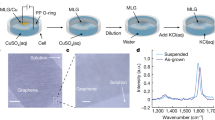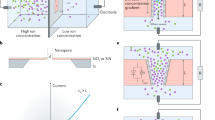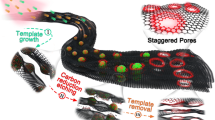Abstract
Water evaporation is a ubiquitous natural process1 that harvests thermal energy from the ambient environment. It has previously been utilized in a number of applications2,3 including the synthesis of nanostructures4 and the creation of energy-harvesting devices5,6. Here, we show that water evaporation from the surface of a variety of nanostructured carbon materials can be used to generate electricity. We find that evaporation from centimetre-sized carbon black sheets can reliably generate sustained voltages of up to 1 V under ambient conditions. The interaction between the water molecules and the carbon layers and moreover evaporation-induced water flow within the porous carbon sheets are thought to be key to the voltage generation. This approach to electricity generation is related to the traditional streaming potential7, which relies on driving ionic solutions through narrow gaps, and the recently reported method of moving ionic solutions across graphene surfaces8,9, but as it exploits the natural process of evaporation and uses cheap carbon black it could offer advantages in the development of practical devices.
This is a preview of subscription content, access via your institution
Access options
Access Nature and 54 other Nature Portfolio journals
Get Nature+, our best-value online-access subscription
$29.99 / 30 days
cancel any time
Subscribe to this journal
Receive 12 print issues and online access
$259.00 per year
only $21.58 per issue
Buy this article
- Purchase on Springer Link
- Instant access to full article PDF
Prices may be subject to local taxes which are calculated during checkout




Similar content being viewed by others
References
Penman, H. L. Natural evaporation from open water, bare soil and grass. Proc. R. Soc. Lond. A 193, 120–145 (1948).
Bachhuber, C. Energy from evaporation of water. Am. J. Phys. 51, 259–264 (1983).
Duan, F., Badam, V. K., Durst, F. & Ward, C. A. Thermocapillary transport of energy during water evaporation. Phys. Rev. E 72, 056303 (2005).
Xu, J. et al. Large-scale synthesis of long crystalline Cu2−xSe nanowire bundles by water-evaporation-induced self-assembly and their application in gas sensing. Adv. Funct. Mater. 19, 1759–1766 (2009).
Chen, X., Mahadevan, L., Driks, A. & Sahin, O. Bacillus spores as building blocks for stimuli-responsive materials and nanogenerators. Nat. Nanotech. 9, 137–141 (2014).
Chen, X. et al. Scaling up nanoscale water-driven energy conversion into evaporation-driven engines and generators. Nat. Commun. 6, 7346 (2015).
Wagenen, R. A. & Andrade, J. D. Flat plate streaming potential investigations: hydrodynamics and electrokinetic equivalency. J. Colloid Interf. Sci. 76, 305–314 (1980).
Yin, J. et al. Waving potential in graphene. Nat. Commun. 5, 3582 (2014).
Yin, J. et al. Generating electricity by moving a droplet of ionic liquid along graphene. Nat. Nanotech. 9, 378–383 (2014).
Yuan, L. Y. et al. Carbon nanoparticles on carbon fabric for flexible and high performance field emitters. Adv. Funct. Mater. 21, 2150–2154 (2011).
Jawhari, T., Roid, A. & Casado, J. Raman spectroscopic characterization of some commercially available carbon black materials. Carbon 33, 1561–1565 (1995).
Portet, C., Yushin, G. & Gogotsi, Y. Electrochemical performance of carbon onions, nanodiamonds, carbon black and multiwalled nanotubes in electrical double layer capacitors. Carbon 45, 2511–2518 (2007).
Deegan, R. D. et al. Capillary flow as the cause of ring stains from dried liquid drops. Nature 389, 827–829 (1997).
Birdi, K. S., Vu, D. T. & Winter, A. A study of the evaporation rates of small water drops placed on a solid surface. J. Phys. Chem. 93, 3702–3703 (1989).
Kresse, G. & Hafner, J. Ab initio molecular dynamics for liquid metals. Phys. Rev. B 47, 558–561 (1993).
Kresse, G. & Furthmüller, J. Efficient iterative schemes for ab initio total-energy calculations using a plane-wave basis set. Phys. Rev. B 54, 11169–11186 (1996).
Kresse, G. & Joubert, D. From ultrasoft pseudopotentials to the projector augmented-wave method. Phys. Rev. B 59, 1758–1775 (1999).
Müller, J. O. et al. Morphology-controlled reactivity of carbonaceous materials towards oxidation. Catal. Today 102–103, 259–265 (2005).
Van der Heyden, F. H. J., Bonthuis, D. J., Stein, D., Meyer, C. & Dekker & C. Power generation by pressure-driven transport of ions in nanofluidic channels. Nano Lett. 7, 1022–1025 (2007).
Kárl, P. & Shapiro, M. Nanotube electron drags in flowing liquids. Phys. Rev. Lett. 86, 131–134 (2001).
Zhao, Y. et al. Individual water-filled single-walled carbon nanotubes as hydroelectric power converters. Adv. Mater. 20, 1772–1776 (2008).
Liu, Z. et al. Surface energy generator of single-walled carbon nanotubes and usage in a self-power system. Adv. Mater. 22, 999–1003 (2010).
Yin, J., Zhang, Z. H., Li, X. M., Zhou, J. X. & Guo, W. L. Harvesting energy from water flow over graphene? Nano Lett. 12, 1736–1741 (2012).
Yan, Y., Timoner, J. V. I. & Grzybowski, B. A. A long-lasting concentration cell based on a magnetic electrolyte. Nat. Nanotech. 9, 901–906 (2014).
Dresselhaus, M. S. & Thomas, I. L. Alternative energy technologies. Nature 414, 332–337 (2001).
Wu, W. Z. et al. Piezoelectricity of single-atomic-layer MoS2 for energy conversion and piezotronics. Nature 514, 470–474 (2014).
Saadon, S. & Sidek, O. A review of vibration-based MEMS piezoelectric energy harvesters. Energy Convers. Manage. 52, 500–504 (2011).
Khaligh, A. & Onar, O. C. Energy Harvesting: Solar, Wind, and Ocean Energy Conversion Systems (CRC Press, 2010).
Ghasemi, H. et al. Solar steam generation by heat localization. Nat. Commun. 5, 4449 (2014).
Perdew, J. P., Burke, K. & Ernzerhof, M. Generalized gradient approximation made simple. Phys. Rev. Lett. 77, 3865–3868 (1996).
Acknowledgements
This work was financially supported by the National Natural Science Foundation of China (51322210, 51672097, 51472117, 51535005), 973 programs (2013CB932604), a Foundation for the Author of National Excellent Doctoral Dissertation of PR China (201035), the National Program for Support of Top-notch Young Professionals and Director Fund of WNLO. We thank Y. Gogotsi, M. Xu, J. Tang, S. Q. Zeng, K. Lu, H. J. Gao, X. C. Zeng, Z. L. Wang and Z. H. Zhang for helpful discussions and suggestions, and K. Liu for help in the streaming potential test.
Author information
Authors and Affiliations
Contributions
J.Z. and W.G. conceived and designed the study; G.X., T.D., J.L., W.F., J.Yin, Y.C. and L.Y. performed the experiments, Y.X. and J.Yu conducted the simulations; L.G., J.C. and S.D. took part in characterizing the samples; W.G. and J.Z. analysed the results with contributions from all authors and wrote the manuscript.
Corresponding authors
Ethics declarations
Competing interests
The authors declare no competing financial interests.
Supplementary information
Supplementary information
Supplementary information (PDF 2406 kb)
Supplementary Movie 1
Supplementary Movie 1 (MOV 7490 kb)
Supplementary Movie 2
Supplementary Movie 2 (MOV 4131 kb)
Rights and permissions
About this article
Cite this article
Xue, G., Xu, Y., Ding, T. et al. Water-evaporation-induced electricity with nanostructured carbon materials. Nature Nanotech 12, 317–321 (2017). https://doi.org/10.1038/nnano.2016.300
Received:
Accepted:
Published:
Issue Date:
DOI: https://doi.org/10.1038/nnano.2016.300
This article is cited by
-
Sustainable moisture energy
Nature Reviews Materials (2024)
-
A high-current hydrogel generator with engineered mechanoionic asymmetry
Nature Communications (2024)
-
Passive interfacial cooling-induced sustainable electricity–water cogeneration
Nature Water (2024)
-
Nature-inspired interfacial engineering for energy harvesting
Nature Reviews Electrical Engineering (2024)
-
Structure integration and architecture of solar-driven interfacial desalination from miniaturization designs to industrial applications
Nature Water (2024)



